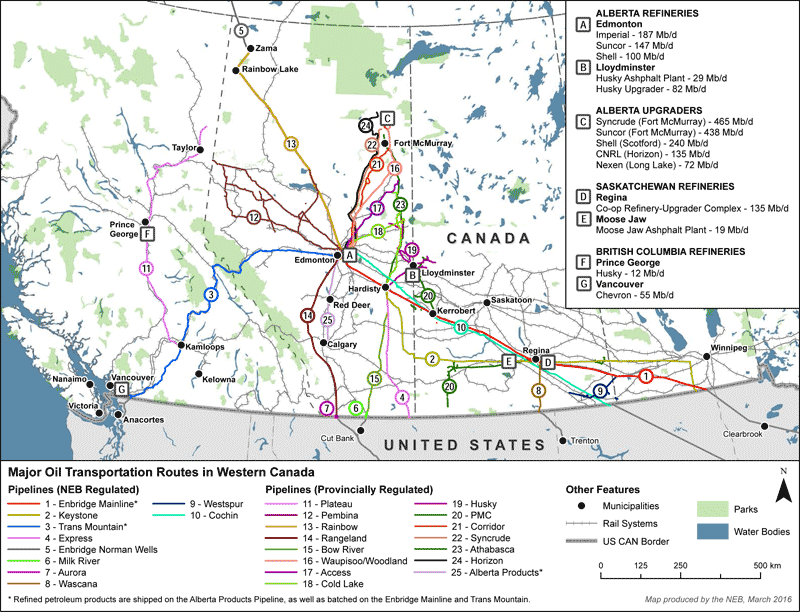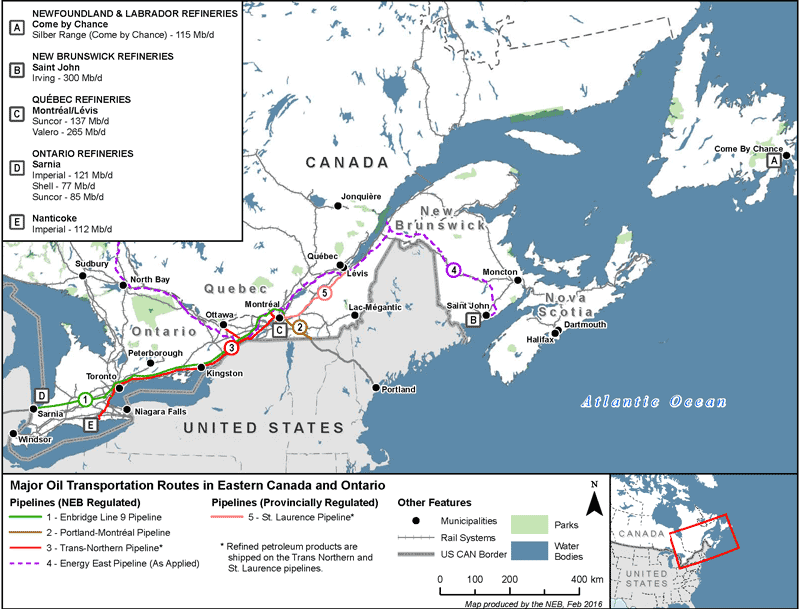Market Snapshot: Understanding the Production, Transport, and Refining of Crude Oil in Canada
Release date: 2016-04-29
In 2015, Canadian crude oil production and export volumes reached all-time highs, while import volumes and refinery runs reversed recent downward trends. As a result, total Canadian crude oil supply (production plus imports) and total Canadian crude oil disposition (exports plus refinery runs) balanced in 2015 at a record high of nearly 4.7 million barrels per day (MMb/d).Footnote 1
Figure Sources and Description
Sources: NEB, Statistics Canada
Description: The above column chart shows Canadian crude oil supply and disposition for 2010 to 2015. During this time frame, Canadian crude oil:
- production increased consistently from 2.83 MMb/d to 3.91 MMb/d
- imports decreased from 0.82 MMb/d to 0.64 MMb/d in 2014, but rebounded to 0.74 MMb/d in 2015
- exports by pipeline increased consistently from 1.82 MMb/d to 2.79 Mb/d
- exports by rail increased from almost nothing to 0.163 MMb/d in 2014, but dipped to 0.11 MMb/d in 2015
- exports by ship were relatively flat at 0.14 MMb/d
- refinery runs fluctuated around 1.67 MMb/d, with 2015 showing an increase for the first time since 2012
Over 95% of Canada’s 3.9 MMb/d of crude oil production in 2015 was pulled from western Canadian reservoirs, mostly in northern Alberta. A group of provincially regulated pipelines moves that crude oil from northern Alberta to the major pipeline and refinery hubs in Edmonton and Hardisty. These pipeline hubs are also pricing points for benchmark grades of crude oil.
At the Edmonton hub, Alberta’s light crude oil is mixed in storage terminals and traded using the “mixed sweet” (MSW) price reference. At Hardisty, heavy Alberta oil is delivered to the Enbridge Mainline, Keystone Pipeline, or rail loading facilities, where several producers co-mingle and market their product, and then trade it using the Western Canadian Select (WCS) price reference.
Edmonton refineries supply most of the gasoline, diesel, and jet fuel used in Alberta, and they also supplement the supply of refined products in Saskatchewan, Manitoba, and B.C. Most of the refined products produced in Edmonton are transported on the Alberta Products Pipeline, Enbridge Mainline, or Trans Mountain Pipeline to marketing terminals throughout western Canada, after which further distribution is typically done by truck and rail.
Figure Sources and Description
Sources: NEB, CAPP, company websites
Description: The above map shows oil transportation systems in western Canada, including railroads and major pipelines (both NEB regulated and provincially regulated). The map also shows the location of refineries and upgraders in the region. The Edmonton and Hardisty hubs are key points on the map, as several pipelines bring oil from northern Alberta to these hubs, after which several other (typically larger) pipelines deliver this oil to other provinces and the U.S. There are eight refineries in western Canada, with most of the capacity in Edmonton, Regina or Vancouver. Two of those refineries primarily produce asphalt from heavy oil. The Moosejaw refinery also performs heavy oil upgrading, along with the six upgraders in Fort McMurray or Lloydminster.
In 2015, 2.8 MMb/d of western Canadian crude oil was exported on six NEB-regulated export pipelines (Enbridge Mainline, Keystone, Trans Mountain, Express, Milk River, and Aurora). Additionally, about 111 Mb/d was exported from western Canada to the US via rail and 143 Mb/d of eastern Canadian offshore production was exported by sea. The majority of exports to the U.S. are to the Midwest, while exports to the Gulf Coast have grown the most rapidly in recent years. Both regions possess significant refining capacity appropriate for heavy Canadian crude.
Approximately 400 Mb/d of western Canadian crude oil was shipped to refineries in Ontario, Quebec, and New Brunswick, mostly on the Enbridge system (the Mainline and Line 9), with approximately 45 Mb/d moving by rail. The refineries in Ontario now run mostly western Canadian crude, while refineries east of Ontario are increasingly running crude oil from both western Canada and the U.S. Nearly all of Canada’s oil imports are destined for eastern Canadian refineries.
Figure Sources and Description
Sources: NEB, CAPP, company websites
Description: The above map shows oil transportation systems in Ontario and Eastern Canada, including railroads and major pipelines (both NEB regulated and provincially regulated). The map also shows the location of refineries in the region. Montreal is a central point on this map, as it is where all of the operational oil pipelines either terminate (Line 9, Portland-Montreal, St. Laurence) or start (Trans-Northern). The CP Railroad also terminates in Montreal, while CN’s railroads stretch into northern Quebec and the Maritimes. The map also shows the route of the proposed Energy East pipeline, which would connect to the three largest refineries in eastern Canada (Suncor, Valero, and Irving).
The refineries in southern Ontario supply most of the refined petroleum products needed in that area. The large refineries in Saint John, Quebec City, and Montreal produce more refined products than are needed in the region. Two pipelines (Trans Northern and St. Laurence) move surplus refined products within Quebec and between Quebec and Ontario, while most of the movement of surplus refined products from the Maritimes is by ship.
- Date modified:


